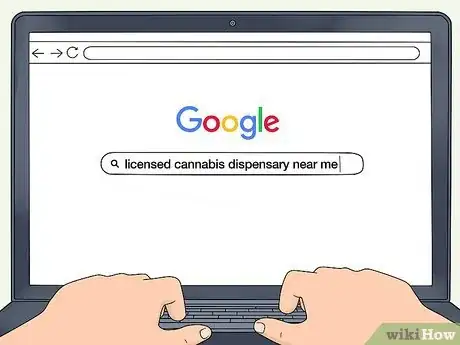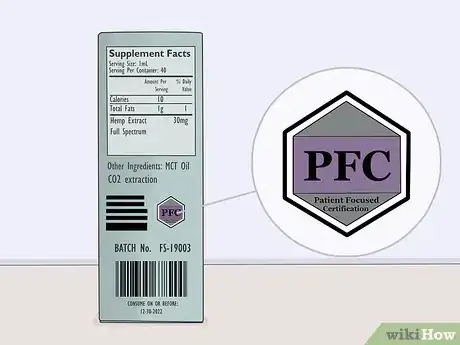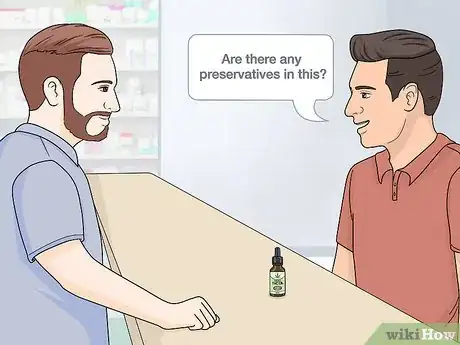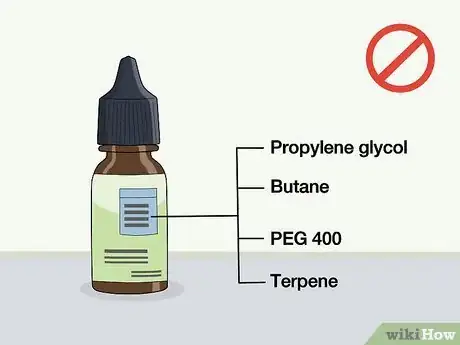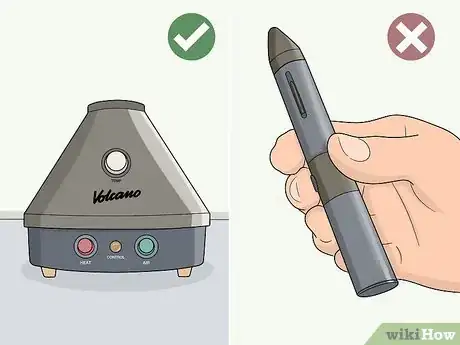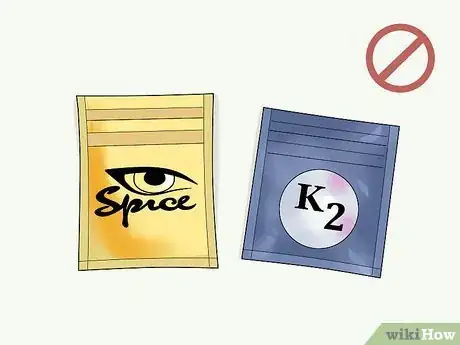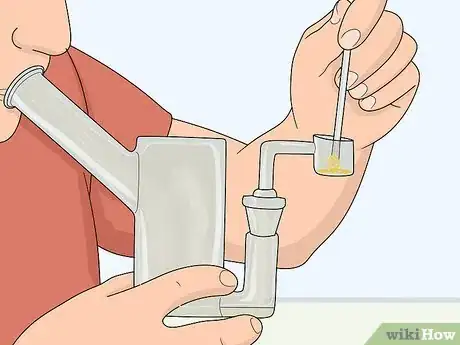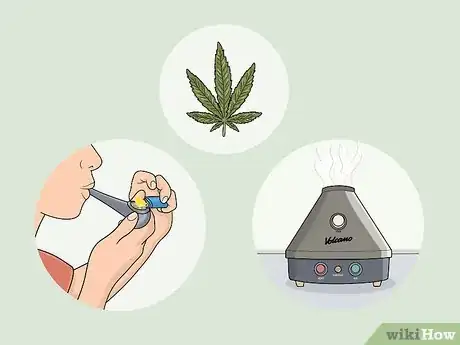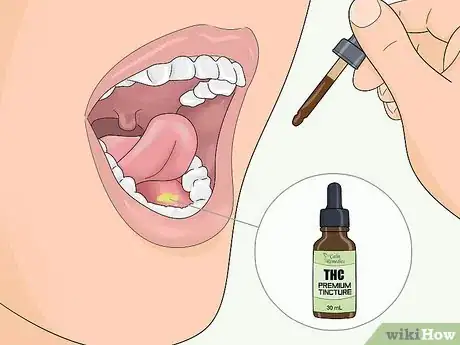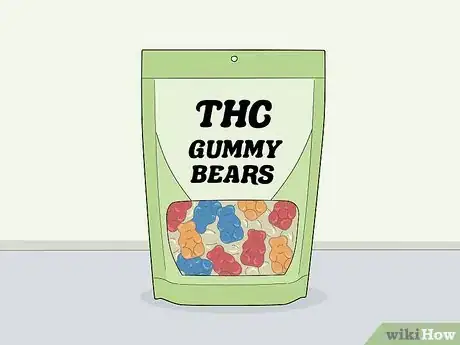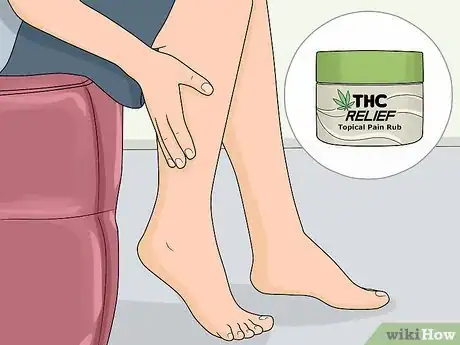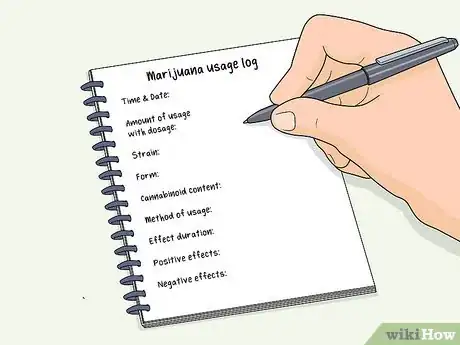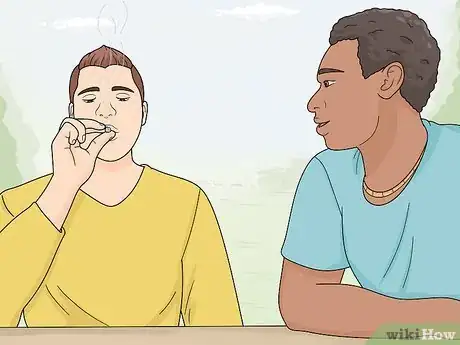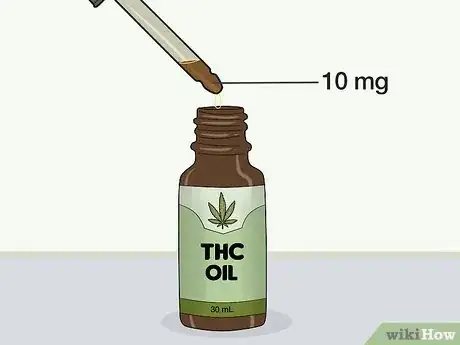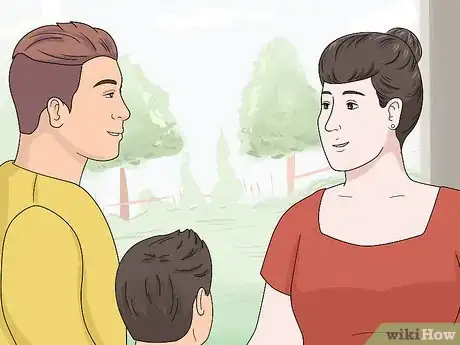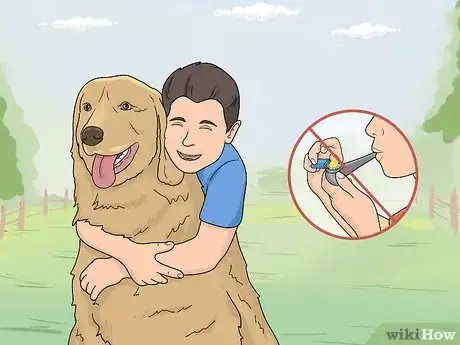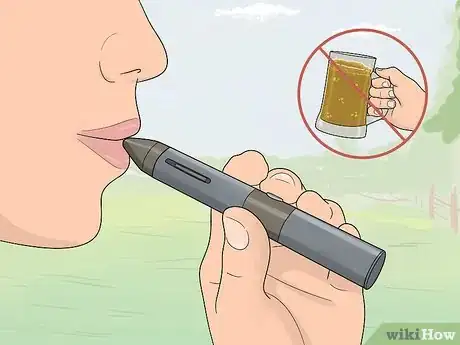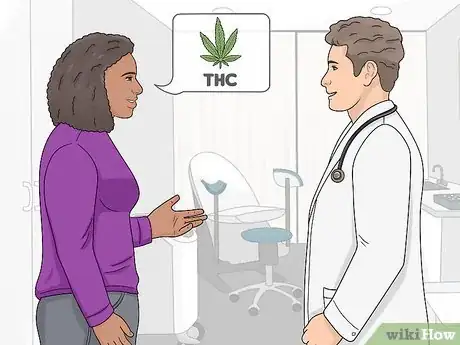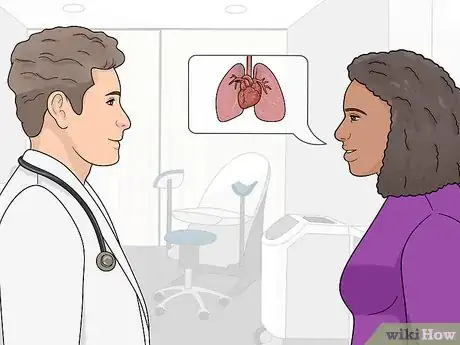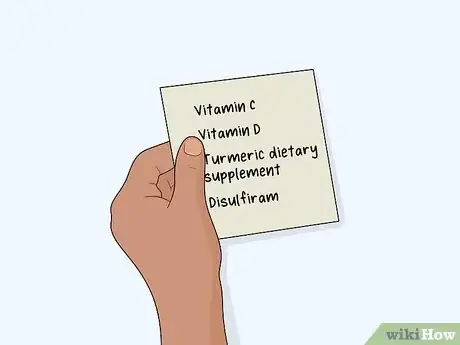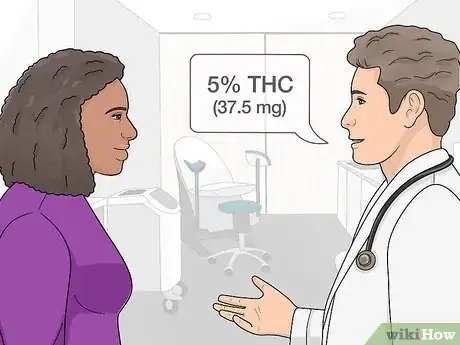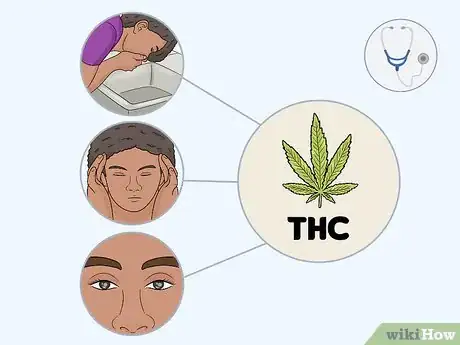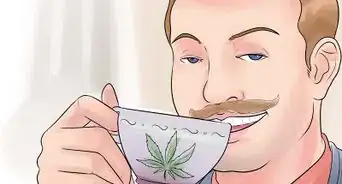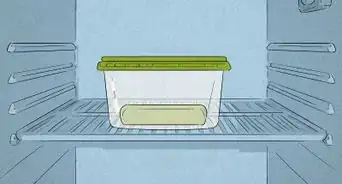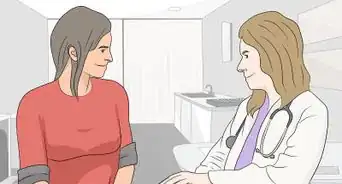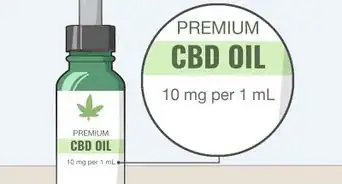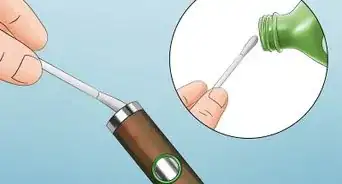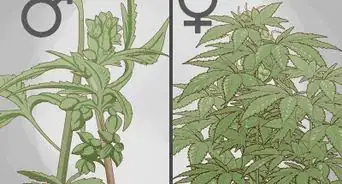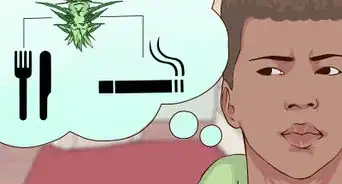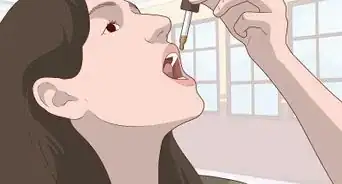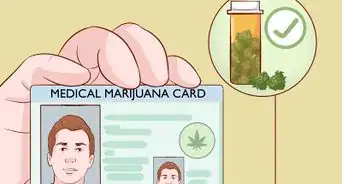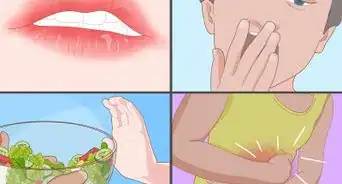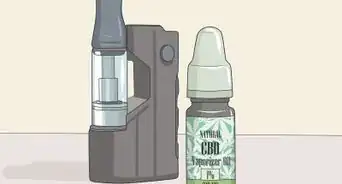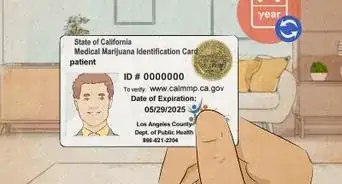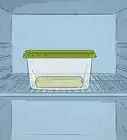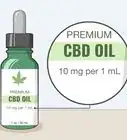This article was co-authored by Liana Georgoulis, PsyD and by wikiHow staff writer, Megaera Lorenz, PhD. Dr. Liana Georgoulis is a Licensed Clinical Psychologist with over 10 years of experience, and is now the Clinical Director at Coast Psychological Services in Los Angeles, California. She received her Doctor of Psychology from Pepperdine University in 2009. Her practice provides cognitive behavioral therapy and other evidence-based therapies for adolescents, adults, and couples.
There are 15 references cited in this article, which can be found at the bottom of the page.
This article has been viewed 11,381 times.
THC (tetrahydrocannabinol) is a compound that naturally occurs in the marijuana plant. THC is best known for creating the euphoric “high” that you get when you smoke marijuana. It also has a variety of potential health benefits, such as nausea reduction, pain relief, and stimulation of the appetite.[1] If you’re nervous about trying THC for the first time, the good news is that it’s fairly safe for most people when used correctly. Talk to your doctor about the potential risks and benefits and get their advice on how to use it safely. Depending on the legal status of marijuana and other cannabis products in your area, you’ll probably need to get a medical marijuana card. In addition to choosing safe products and following your doctor’s advice, it’s also important to be responsible while using THC and avoid doing activities that could put yourself and others in danger.
Steps
Choosing Safe Products
-
1Get your products from a reputable clinic or dispensary. In areas where medical or recreational marijuana use is legal, THC products are required to meet certain standards of safety. Maximize your chances of getting safe, effective products by visiting a licensed clinic or dispensary. Ask your doctor to recommend one, or do an online search using terms like “licensed cannabis dispensary near me.”[2]
- If you live in a state in the U.S. where marijuana is legalized, check your state government’s website for information about local cannabis laws and a list of licensed dispensaries in your area.
-
2Purchase products that are third-party certified. The regulations that govern the production of THC products are still evolving. However, new testing laws are starting to go into effect to help ensure the safety and purity of these products. When buying THC in any form, check for the seal of a third-party testing organization, such as PFC (Patient Focused Certification) or Alliance Analytical Laboratories.[3]
- You can find information about other accredited third-party testing labs by searching for “THC” on the American National Standards Institute National Accreditation Board website: http://search.anab.org/.
Advertisement -
3Ask for information about how the products were tested and manufactured. When purchasing THC products, don’t hesitate to ask questions. Find out as much as you can about how the plants were grown, how the product was manufactured, and what kinds of measures the manufacturers took to ensure its safety and quality.[4]
- For example, you might ask questions like, “Were the plants grown without pesticides?” or “Are there any preservatives in this?”
- Ask to see documentation about the results of any safety and quality tests.
-
4Avoid using products that contain propylene glycol and other additives. Cannabis products—and vaping oils in particular—sometimes contain additives that can be dangerous to your health. Before using any product, check the label carefully. Don’t smoke or vape products that include ingredients such as:[5]
- Propylene glycol
- Hydrocarbons, such as butane or propane
- PG or PEG 400 (also known as polyethylene glycol)
- Added terpenes
-
5Use a true vaporizer rather than a vape pen. In many ways, vaporizing cannabis is safer than smoking. This is because vaporizing heats the THC oils and releases a vapor without also releasing smoke, tars, and other irritants that result from burning marijuana plants. To vaporize your marijuana safely, use a tabletop vaporizer (such as a Volcano Vaporizer) rather than a vape pen.[6]
- If you use a vape pen or handheld vaporizer, use one that allows you to heat raw cannabis if possible. Most vape pens require you to use cartridges containing THC oil concentrates, which often contain other additives that may be unsafe when heated.[7]
-
6Steer clear of synthetic cannabinoids. While natural THC from cannabis plants is thought to be relatively safe, synthetic forms of the drug are much stronger and are more likely to cause dangerous side effects. Avoid using synthetics such as K2, spice, or spike.[8]
- Synthetic cannabinoids can cause side effects such as nausea, anxiety, aggression, paranoia, hallucinations, seizures, chest pain, heart palpitations, and swelling of the brain.
-
7Avoid using waxes or dabs. “Dabbing” involves smoking a highly concentrated THC wax or oil. While this method can give you very quick and powerful results, it can also be dangerous if you don’t already have a high tolerance for THC. Additionally, many of these waxes contain highly flammable components, such as butane, which can catch fire when you heat them. Steer clear of these forms of marijuana, especially if you’re an inexperienced user.[9]
- Dabs and waxes contain such high concentrations of THC that they can cause unusually strong side effects, such as hallucinations or instant loss of consciousness.
Administering THC
-
1Experiment with different strains to see how they affect you. Not all marijuana plants are the same. Different strains contain different concentrations of THC, CBD (cannabidiol), and other natural chemicals that can affect your mind and body in different ways. Talk to a doctor at a marijuana clinic or a staff member at a reputable dispensary about what you might expect from the different strains. When you try different types, keep track of how you react so you can keep getting the strains that work for you (and avoid the ones that don’t).[10]
- For example, plants that are high in myrcene have a more sedative effect, while those with a bit more CBD are more likely to perk you up.
Warning: You may have heard that the long-leaved sativa species of marijuana can energize you, while the bushier indica variety is more likely to make you sleepy and mellow. However, the truth is a lot more complicated. There are many different strains of marijuana on the market today, and the kind of effects you’ll experience depend on the chemical makeup of the plant. You can’t tell what a plant will do based on what it looks like.[11]
-
2Smoke marijuana or use a vaporizer for immediate results. If you need quick relief from symptoms such as pain, nausea, tremors, or loss of appetite, smoking or vaporizing your marijuana are good, relatively safe options.[12] Take small, shallow puffs and avoid holding the smoke or vapor in your lungs, since this won’t make the THC more effective and is more likely to cause coughing and irritation. You should feel the effects within 1-3 minutes.
- Unlike smoking tobacco products, smoking marijuana has not been shown to cause health problems such as cancer or COPD.[13]
- While smoking and vaporizing THC are both relatively safe, vaporizing has been shown to significantly reduce the quantity of toxins that you are likely to inhale along with the THC. Vaporizing may also help prevent some of the loss of THC that occurs with smoking.[14]
-
3Use a THC tincture for fast absorption if you don’t want to inhale it. If you’re worried about the potential ill effects of inhaling THC, you can try using a tincture as a relatively safe and quick alternative. Tinctures are drops or sprays that you apply to the inside of your cheeks or under your tongue, where the THC can be quickly absorbed into your bloodstream. Use 1-2 drops or puffs of spray, then wait up to 1 hour to see if you get the results you want. If not, you can add a little more.[15]
- Always follow the directions on the package carefully when using a tincture. Applying the tincture to the wrong part of your mouth or swallowing it too quickly may reduce or delay its effectiveness.
- Most tinctures begin working within 15-30 minutes after application.
-
4Use edibles to minimize your chance of side effects. One of the safest ways to take THC is to eat it. This way, you’re not inhaling any smoke or heated vapors, which could potentially cause irritation. Eat a small amount of the edible of your choice, then wait 2 hours to see how you feel. If necessary, eat a little more to get the desired effect.[16]
- It can take up to an hour for you to feel the effects of THC in edible form. However, you may feel the effects more strongly and they might last longer than they would if you smoked the cannabis or ingested it in some other way.
- It can be hard to judge the dosage you’re getting with some edibles, such as baked goods. To control the amount you consume more precisely, try using pills or capsules. Many pre-made edibles, such as gummies, are also labeled with the exact dosage of THC they contain (such as 5 mg per gummy).
Did You Know? You can get edible THC products in the form of baked goods (like brownies, cookies, or cakes), gummies and other candies, and even beverages, such as THC-infused coffee or tea. You can also purchase THC-based cooking oils or butters that you can use to make your own edibles.
-
5Apply a topical rub for localized relief from pain and inflammation. Studies have shown that THC applied topically (to the skin) can help reduce inflammation.[17] Try topical THC products, such as lotions, rubs, and balms, to get relief from issues such as muscle aches and cramps, arthritis, or allergic rashes.[18]
- In most cases, you can simply massage the product directly onto your skin in the affected area. Check the label for specific instructions.
- One advantage of topical cannabis products is that they only work locally and are not absorbed into the bloodstream. This means that you can get the benefits of the medicine without the psychoactive effects.
- While topical cannabis applications are generally thought to be safe, additives in these products may be irritating to some people. If you have sensitive skin, look for products that don’t contain perfumes or dyes.
-
6Keep a log to track your reactions to different doses and methods. Whenever you take a dose of marijuana, write down as much information as possible, including what you took, when, and how you reacted to it. This will help you get a better sense of what works for you and what doesn’t. Your log should include information such as:[19]
- The date and time of administration
- How much you used (with precise doses if possible)
- The strain of marijuana you used
- The form of the marijuana (e.g., dried bud, tincture, edible, topical)
- The cannabinoid content (that is, the percentages of different cannabinoids, such as THC, CBD, and CBN)
- How you used the marijuana (such as smoking, vaporizing, or ingesting)
- How long it took to experience obvious effects
- Any effects you experienced, positive or negative (such as euphoria, relief from symptoms you were trying to treat, sleepiness, or anxiety)
Staying Safe While under the Influence
-
1Try THC in a safe environment, especially the first time. If you’re not used to using THC, it can be hard to know how it will affect you. Stay safe by using it in a secure, familiar environment, and only using it around people you trust.[20]
- For example, trying THC at home with a sober friend or partner is a good approach. That way, they can keep an eye on you and get help if you experience any unpleasant or dangerous side effects.
- Don’t try THC in a strange place or with people you don’t know.
-
2Start with low doses if you’re not used to THC. THC affects everyone differently. Until you know how you’ll react to the drug, use small amounts so that you won’t be caught off guard by the effects. From there, you can gradually build up to taking higher doses.[21]
- For example, you might start with a dose of less than 10 mg, then take a little more if you don’t get the desired results (such as reduced pain or nausea).
- As you get used to THC, you may have to gradually increase the amount you take in order to get the effect you want. Use a resource like the LA Times THC calculator to help you get a sense of the right dose based on your experience level: https://www.latimes.com/projects/la-me-weed-101-thc-calculator/
- If you do accidentally take too much, don’t panic. You’re unlikely to experience any dangerous side effects, but you may feel very uncomfortable. Have a trusted friend or family member stay with you and try to relax until you feel better.[22]
-
3Don’t drive or use heavy machinery while using THC. Driving while under the influence of THC can increase your risk of getting into accidents. To keep yourself and others safe, stay off the road and don’t operate heavy equipment (such as construction vehicles) or other potentially dangerous machines while you’re feeling the effects of THC.[23]
- If you use THC in edible form, be aware that it could take 30 minutes to an hour before you start noticing the effects. Avoid driving after consuming any edibles, even if you don’t feel anything right away.
-
4Ask someone who is sober to watch your children if you have them. If you have kids, especially small children who need adult supervision, make sure someone is able to care for them while you’re under the influence of THC.[24] Using THC can impair your judgment and make it harder for you to care for your children safely.
- For example, you might ask your partner to watch the kids if they aren’t using THC as well, or have a relative or babysitter watch them for a while.
-
5Avoid smoking THC around children or pets. Secondhand smoke from marijuana can have an impact on the health of children and animals. Don’t smoke or vaporize cannabis products around pets or kids, and always keep these products locked up and out of the reach of children and animals when you’re not using them.[25]
- If you think a child has ingested cannabis, call emergency services or your local poison control hotline immediately. If you live in the U.S., you can reach the national Poison Control Center at 1-800-222-1222.
- If you think your pet has ingested cannabis, call your vet right away.
-
6Refrain from drinking alcohol while you’re using THC. THC can interact with alcohol and make its effects more powerful.[26] Similarly, alcohol can increase the effects of THC.[27] To reduce your risk of developing alcohol poisoning or other unwanted side effects, don’t use THC and alcohol together.
- One of the dangers of mixing THC and alcohol is that using THC can make it harder for you to vomit. This means that if you drink too much alcohol, your body will have a harder time getting the excess alcohol out of your system.
Working with Your Doctor
-
1Talk to your doctor before trying THC. While taking THC can be beneficial for many people, it can also have a variety of potential risks and side effects. Before you use THC, consult with your doctor to find out if it’s likely to be safe and effective for you.[28]
- Your doctor can also recommend safe products and talk to you about how to use them correctly. If they’re not experienced with THC, they may be able to refer you to a doctor who is.
- If you’re already using marijuana, be open and honest with your doctor about it. Explain to them that you want to know more about the potential risks and benefits of using THC for your health.[29]
- If your doctor thinks you can benefit from using medical marijuana, they may prescribe a THC-based pharmaceutical, such as dronabinol or Sativex. These medications are typically prescribed to treat symptoms associated with chemotherapy side effects, HIV/AIDS, cancer, and multiple sclerosis.
-
2Discuss any current health conditions you have with your doctor. THC may cause problems for people with certain health conditions. Talk to your doctor about your health history and any current issues you may be having so that they can advise you on whether it’s safe for you to use THC.[30]
- Your doctor may recommend that you avoid using THC if you are pregnant or nursing, have any psychiatric conditions (such as schizophrenia or bipolar disorder), or have heart, kidney, liver, or lung disease.
-
3Give your doctor a list of any medications you’re currently taking. It’s possible that THC or other cannabinoids could interact with other medications or supplements. Before you try THC, give your doctor a full list of any prescription drugs, over-the-counter medications, or dietary supplements you’re currently using. They can let you know whether you can safely use them in combination with THC.[31]
- THC may interact with medications such as barbiturates (sleep medications), antihistamines, disulfiram, theophylline, fluoxetine, and blood thinners.
-
4Follow your doctor’s dosage instructions carefully. Taking too much THC can cause unwanted side effects. Using carefully-controlled doses can help reduce your risk of side effects or other complications. Work with your doctor to choose doses that are safe and effective for you.[32]
- Your doctor may advise starting with an amount lower than the recommended dose, then gradually increasing the amount of THC you consume until you get the desired effect.
-
5Seek medical help if you experience serious side effects. Most side effects from THC are relatively mild, but it can sometimes cause severe symptoms. Stop using THC and get medical help immediately if you experience effects such as panic attacks, severe nausea, and vomiting, convulsions, or symptoms of psychosis (such as hallucinations, severe paranoia, or delusions).[33]
- More common side effects of THC include headaches, dry mouth, dry or red eyes, coughing, dizziness, drowsiness or fatigue, increased appetite, anxiety, and feelings of disconnectedness from reality.[34]
Expert Q&A
Did you know you can get expert answers for this article?
Unlock expert answers by supporting wikiHow
-
QuestionIs smoking marijuana safe?
 Liana Georgoulis, PsyDDr. Liana Georgoulis is a Licensed Clinical Psychologist with over 10 years of experience, and is now the Clinical Director at Coast Psychological Services in Los Angeles, California. She received her Doctor of Psychology from Pepperdine University in 2009. Her practice provides cognitive behavioral therapy and other evidence-based therapies for adolescents, adults, and couples.
Liana Georgoulis, PsyDDr. Liana Georgoulis is a Licensed Clinical Psychologist with over 10 years of experience, and is now the Clinical Director at Coast Psychological Services in Los Angeles, California. She received her Doctor of Psychology from Pepperdine University in 2009. Her practice provides cognitive behavioral therapy and other evidence-based therapies for adolescents, adults, and couples.
Licensed Psychologist
-
QuestionWhat does it feel like to be high on THC?
 Liana Georgoulis, PsyDDr. Liana Georgoulis is a Licensed Clinical Psychologist with over 10 years of experience, and is now the Clinical Director at Coast Psychological Services in Los Angeles, California. She received her Doctor of Psychology from Pepperdine University in 2009. Her practice provides cognitive behavioral therapy and other evidence-based therapies for adolescents, adults, and couples.
Liana Georgoulis, PsyDDr. Liana Georgoulis is a Licensed Clinical Psychologist with over 10 years of experience, and is now the Clinical Director at Coast Psychological Services in Los Angeles, California. She received her Doctor of Psychology from Pepperdine University in 2009. Her practice provides cognitive behavioral therapy and other evidence-based therapies for adolescents, adults, and couples.
Licensed Psychologist
-
QuestionHow much THC should I take if I've got edibles?
 Liana Georgoulis, PsyDDr. Liana Georgoulis is a Licensed Clinical Psychologist with over 10 years of experience, and is now the Clinical Director at Coast Psychological Services in Los Angeles, California. She received her Doctor of Psychology from Pepperdine University in 2009. Her practice provides cognitive behavioral therapy and other evidence-based therapies for adolescents, adults, and couples.
Liana Georgoulis, PsyDDr. Liana Georgoulis is a Licensed Clinical Psychologist with over 10 years of experience, and is now the Clinical Director at Coast Psychological Services in Los Angeles, California. She received her Doctor of Psychology from Pepperdine University in 2009. Her practice provides cognitive behavioral therapy and other evidence-based therapies for adolescents, adults, and couples.
Licensed Psychologist
Warnings
- The long-term effects of THC are still poorly understood. It’s possible that using marijuana long-term might contribute to problems such as memory loss, psychiatric issues, high blood pressure, and heart conditions.[35] Discuss the possible risks with your doctor.⧼thumbs_response⧽
References
- ↑ https://www.health.harvard.edu/blog/medical-marijuana-2018011513085
- ↑ https://www.nextavenue.org/medical-marijuana-dispensary/
- ↑ https://www.safeaccessnow.org/is_vaping_cannabis_safe
- ↑ https://www.safeaccessnow.org/is_vaping_cannabis_safe
- ↑ https://www.safeaccessnow.org/is_vaping_cannabis_safe
- ↑ https://www.canorml.org/medical-marijuana/cal-normlmaps-study-shows-vaporizer-can-drastically-reduce-toxins-in-marijuana-smoke/
- ↑ https://www.safeaccessnow.org/is_vaping_cannabis_safe
- ↑ https://www.cdph.ca.gov/Programs/DO/letstalkcannabis/CDPH%20Document%20Library/CDPH-Safe-Responsible_0901.pdf
- ↑ https://www.oxfordtreatment.com/substance-abuse/marijuana/wax/
- ↑ https://www.liebertpub.com/doi/pdf/10.1089/can.2015.29003.ebr
- ↑ https://www.liebertpub.com/doi/pdf/10.1089/can.2015.29003.ebr
- ↑ https://www.safeaccessnow.org/using_medical_cannabis
- ↑ https://doh.dc.gov/sites/default/files/dc/sites/doh/publication/attachments/Medical%20Cannabis%20Adverse%20Effects%20and%20Drug%20Interactions_0.pdf
- ↑ https://www.canorml.org/medical-marijuana/cal-normlmaps-study-shows-vaporizer-can-drastically-reduce-toxins-in-marijuana-smoke/
- ↑ https://www.safeaccessnow.org/using_medical_cannabis
- ↑ https://www.safeaccessnow.org/using_medical_cannabis
- ↑ https://www.ncbi.nlm.nih.gov/pubmed/23889474
- ↑ https://www.safeaccessnow.org/using_medical_cannabis
- ↑ https://www.safeaccessnow.org/using_medical_cannabis
- ↑ https://www.heretohelp.bc.ca/workbook/cannabis-use-and-youth-a-parents-guide
- ↑ https://www.cdph.ca.gov/Programs/DO/letstalkcannabis/CDPH%20Document%20Library/CDPH-Safe-Responsible_0901.pdf
- ↑ https://www.theguardian.com/society/2018/nov/18/marijuana-cannabis-edibles-overdose-too-much
- ↑ https://www.cdph.ca.gov/Programs/DO/letstalkcannabis/CDPH%20Document%20Library/CDPH-Safe-Responsible_0901.pdf
- ↑ https://www.cdph.ca.gov/Programs/DO/letstalkcannabis/CDPH%20Document%20Library/CDPH-Safe-Responsible_0901.pdf
- ↑ https://www.cdph.ca.gov/Programs/DO/letstalkcannabis/CDPH%20Document%20Library/CDPH-Safe-Responsible_0901.pdf
- ↑ https://doh.dc.gov/sites/default/files/dc/sites/doh/publication/attachments/Medical%20Cannabis%20Adverse%20Effects%20and%20Drug%20Interactions_0.pdf
- ↑ https://www.alcohol.org/mixing-with/marijuana/
- ↑ https://www.safeaccessnow.org/using_medical_cannabis
- ↑ https://www.health.harvard.edu/blog/medical-marijuana-2018011513085
- ↑ https://doh.dc.gov/sites/default/files/dc/sites/doh/publication/attachments/Medical%20Cannabis%20Adverse%20Effects%20and%20Drug%20Interactions_0.pdf
- ↑ https://www.safeaccessnow.org/using_medical_cannabis
- ↑ https://www.safeaccessnow.org/cannabis_safety
- ↑ https://www.safeaccessnow.org/cannabis_safety
- ↑ https://www.mayoclinic.org/drugs-supplements-marijuana/art-20364974
- ↑ https://www.mayoclinic.org/drugs-supplements-marijuana/art-20364974
